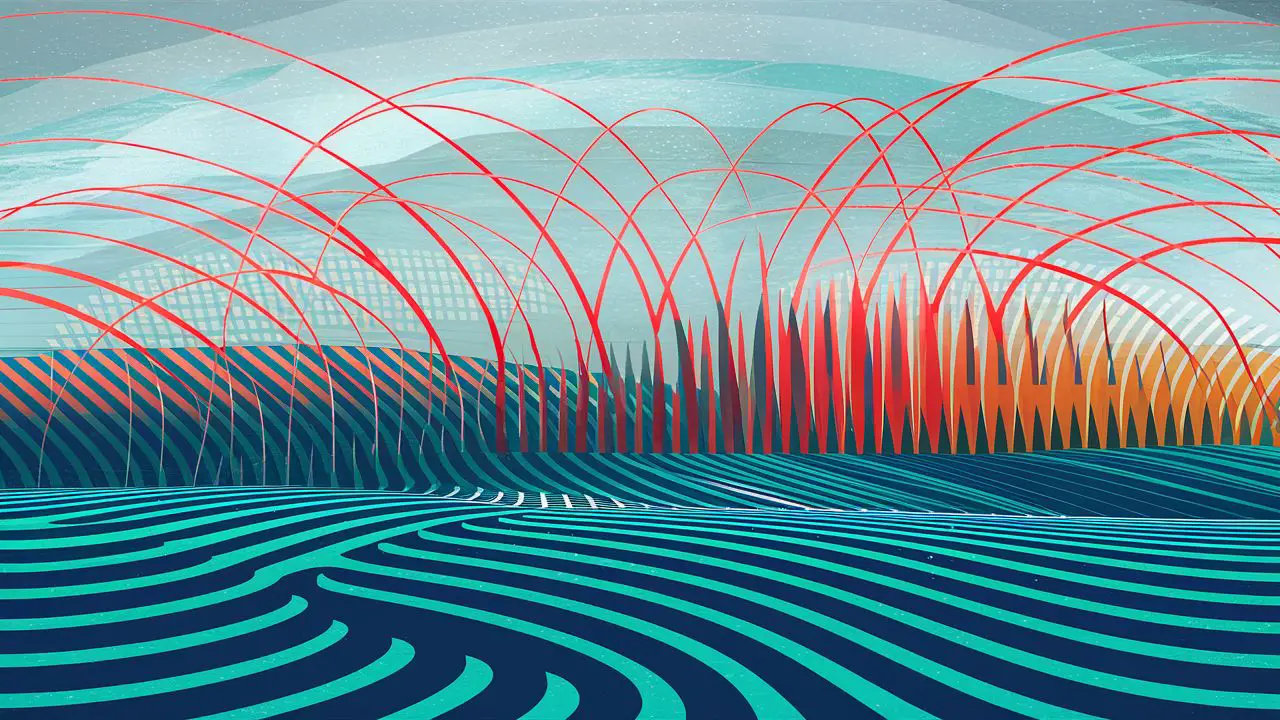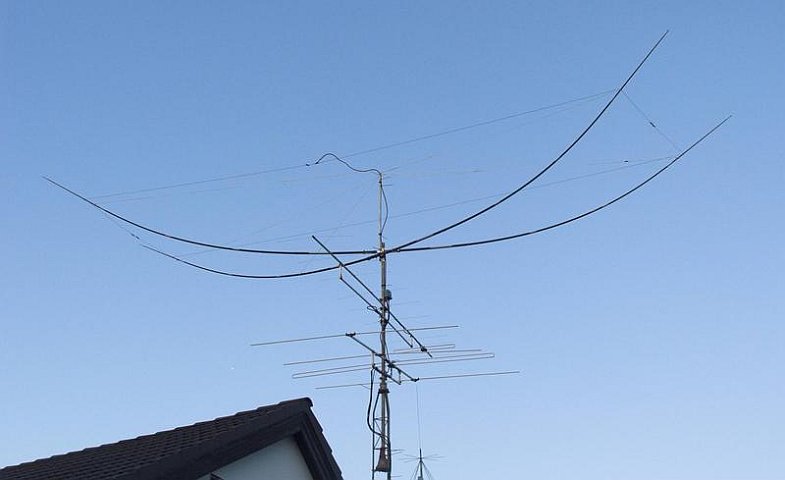Radio wave propagation plays a pivotal role in the world of amateur radio, dictating how signals travel over distances and ultimately determine the reach and clarity of communications. This phenomenon, governed by the principles of physics and influenced by the Earth’s atmosphere and surface, is crucial for amateur radio operators to understand and utilize effectively. The objective of this exploration is to delve into and contrast two primary modes of radio wave propagation: ground wave and skywave. Each mode offers unique advantages and challenges, significantly impacting the strategy behind amateur radio operations, from local communications to long-distance, global interactions. By examining the characteristics, benefits, and limitations of ground wave and skywave propagation, we aim to provide amateur radio enthusiasts with a deeper understanding of how to optimize their communication practices in alignment with these natural phenomena.
- Basics of Radio Wave Propagation
- Ground Wave Propagation
- What is Ground Wave Propagation?
- Components of Ground Waves
- Direct Waves
- Ground-Reflected Waves
- Surface Waves
- Advantages of Ground Wave Propagation
- Limitations
- Skywave Propagation
- The Ionosphere Layers and Their Impact
- D Layer
- E Layer
- F1 and F2 Layers
- Critical Concepts in Skywave Propagation
- Critical Frequency
- Maximum Usable Frequency (MUF)
- Skip Zone
- Advantages and Challenges
- Comparing Ground Wave and Skywave Propagation
- Applications and Limitations
- Ground Wave Propagation
- Skywave Propagation
- Factors Affecting Effectiveness
- Ground Wave
- Skywave
- Leveraging Propagation Knowledge
- Practical Implications for Amateur Radio
- Choosing Appropriate Frequency Bands
- For Ground Wave Communication
- For Skywave Communication
- Antenna Placement and Orientation
- Optimizing for Ground Wave Propagation
- Optimizing for Skywave Propagation
- Tools and Resources for Predicting Propagation Conditions
- Software
- Online Platforms
- Conclusion
- Explore More…
- More Reading
Basics of Radio Wave Propagation
Radio wave propagation refers to the behavior of radio waves as they travel from one point to another through the Earth’s atmosphere or space. This process is influenced by a variety of factors including the frequency of the wave, the characteristics of the transmitting and receiving antennas, atmospheric conditions, and the presence of obstacles like buildings or terrain. Understanding these factors is essential for amateur radio operators to effectively plan and execute their communications.
One fundamental concept in radio wave propagation is the radio horizon, which significantly impacts how far a radio signal can travel. The radio horizon is typically further than the optical horizon—the limit of visible light’s straight-line travel—due to atmospheric refraction. This refraction bends radio waves slightly towards the Earth’s surface, extending their reach beyond the visual line of sight. The difference between the radio and optical horizons means that radio communications can be established over distances greater than those visible to the eye, a fact that is crucial for effective radio operation.
The propagation mode—the path radio waves take from transmitter to receiver—plays a critical role in determining both the reach and clarity of radio communications. Different propagation modes, such as ground wave or skywave, utilize various aspects of the Earth’s environment to travel, each with its advantages and challenges. Ground wave propagation, for instance, follows the curvature of the Earth, making it ideal for short to medium distance communications. In contrast, skywave propagation involves radio waves bouncing off the ionosphere, allowing for long-distance communication beyond the horizon. The choice of frequency, time of day, and atmospheric conditions can all affect which propagation mode will be most effective for a given radio communication effort. Understanding these modes and their influencing factors enables amateur
radio operators to optimize their setups for desired communication distances and conditions, ensuring more reliable and clearer transmissions.
Ground Wave Propagation
What is Ground Wave Propagation?
Ground wave propagation refers to the mode of radio wave transmission where the waves travel along the Earth’s surface. This propagation method is fundamentally influenced by the physical characteristics of the Earth, including its curvature and conductivity. Ground wave propagation is especially relevant at lower frequencies, where radio waves can effectively follow the contour of the Earth, allowing for reliable communication over short to medium distances without the need for line-of-sight.
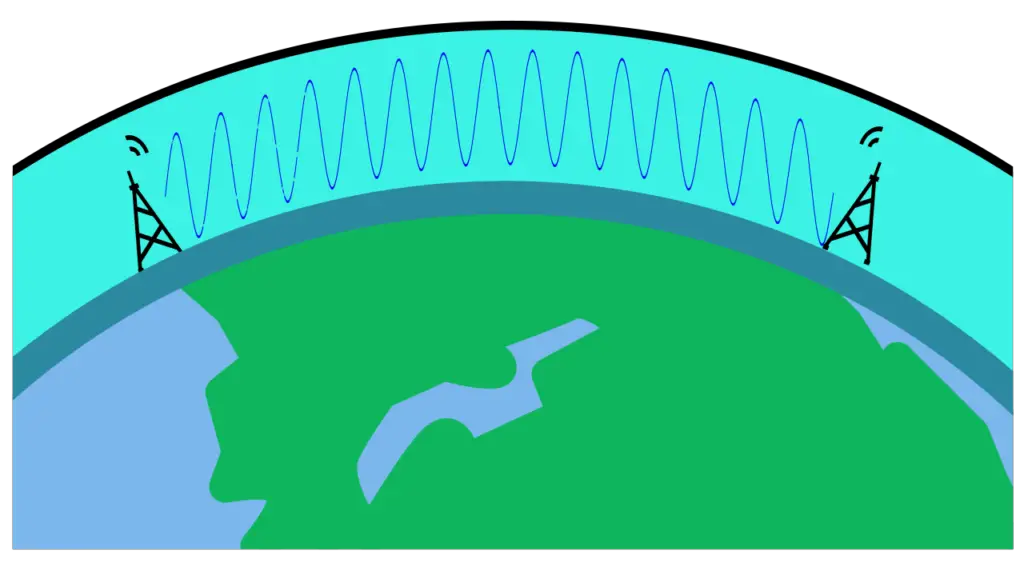
Components of Ground Waves
Direct Waves
These are radio waves that travel directly from the transmitter to the receiver. Their effectiveness is generally limited by the radio horizon, extending slightly beyond the optical line of sight due to atmospheric refraction.
Ground-Reflected Waves
These waves bounce off the Earth’s surface en route to the receiver. The interaction between direct and ground-reflected waves can lead to phase cancellation or reinforcement, affecting the received signal strength.
Surface Waves
Surface waves adhere closely to the Earth’s contours and are significantly influenced by the ground’s conductivity and dielectric properties. These waves tend to attenuate less with distance compared to direct and reflected waves, making them crucial for longer distance ground wave propagation.
Advantages of Ground Wave Propagation
Ground wave propagation is characterized by its reliability for short to medium distance communications, making it particularly advantageous for regional broadcasting and marine navigation. One of its primary benefits is the reduced susceptibility to atmospheric conditions, such as ionospheric disturbances, which can significantly affect other propagation modes. This reliability, coupled with the ability to communicate beyond visual line of sight, makes ground wave a preferred method for consistent, day-to-day radio communications within its effective range.
Limitations
While ground wave propagation offers several advantages, it is not without its limitations. The effectiveness of ground waves diminishes at higher frequencies, where attenuation due to ground absorption increases, reducing the feasible distance for communication. Additionally, the terrain over which the waves travel can impact their propagation; for example, mountains, buildings, and other large obstacles can obstruct or weaken the signal. These limitations necessitate careful consideration of frequency selection and antenna placement to optimize ground wave communication efforts.
Skywave Propagation
Skywave propagation represents a fascinating aspect of radio communication, where radio waves are refracted back to Earth by the ionosphere, enabling long-distance transmissions that far exceed the limitations of ground wave propagation. This mode of propagation takes advantage of the ionosphere’s unique ability to bend and reflect radio waves back towards the Earth’s surface.

The Ionosphere Layers and Their Impact
The ionosphere is composed of several layers—primarily the D, E, F1, and F2 layers—each playing a distinct role in skywave propagation:
D Layer
Present only during daylight hours, it absorbs lower frequency radio waves, making it a challenge for AM broadcasting but less so for higher frequency bands.
E Layer
Capable of reflecting radio waves back to Earth, it supports shorter long-distance communication, especially during the day.
F1 and F2 Layers
These layers merge at night into a single F layer, which supports the longest distance skywave propagation. The F2 layer, in particular, is crucial for HF band transmissions across continents and oceans.
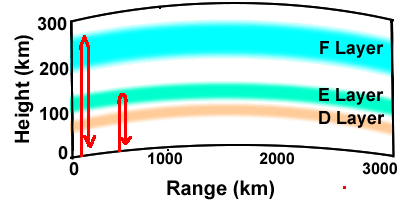
(Source)
Critical Concepts in Skywave Propagation
Critical Frequency
The maximum frequency at which a radio wave can be transmitted vertically and still be refracted back to Earth by the ionosphere. Frequencies above this threshold will escape into space.
Maximum Usable Frequency (MUF)
The highest frequency that can be used for communication between two specific points on Earth at a given time. It varies with the ionosphere’s condition, which is influenced by the time of day and solar activity.
Skip Zone
An area where radio communication is not possible between the transmitter and receiver due to the angles of incidence and refraction. Signals overshoot the area, creating a reception void.
Advantages and Challenges
Skywave propagation opens the door to long-distance communication, bridging continents without the need for satellites or cables. This capability is invaluable for amateur radio operators seeking to make contacts far beyond their local area, especially using the HF bands.
However, this propagation mode is not without its challenges. The variability of the ionosphere, influenced by the solar cycle, time of day, and geomagnetic conditions, introduces unpredictability into skywave communications. Signals can fade, change in quality, or become entirely blocked depending on these conditions. Additionally, understanding and predicting the MUF and navigating around the skip zone require both experience and patience.
Despite these challenges, skywave propagation remains a cornerstone of amateur radio, enabling operators to reach out across vast distances, explore the intricacies of the Earth’s atmosphere, and connect with others worldwide under the right conditions.
Comparing Ground Wave and Skywave Propagation
Ground wave and skywave propagation represent two fundamental mechanisms through which radio waves travel, each with distinct characteristics, applications, and limitations. Understanding these differences is crucial for amateur radio operators to tailor their communication strategies effectively.
Applications and Limitations
Ground Wave Propagation
Ideal for short to medium distance communications, ground wave propagation relies on the Earth’s surface for the radio waves to travel. It is most effective at lower frequencies, typically below 3 MHz. Ground waves are less susceptible to atmospheric conditions, offering more reliable and stable communication channels. However, its effectiveness diminishes with distance and at higher frequencies, where absorption by the Earth significantly weakens the signal. Terrain features like mountains and valleys can also impact the signal’s reach and clarity.
Skywave Propagation
Skywave propagation allows for long-distance communication by refracting radio waves off the ionosphere back to Earth. This mode is highly effective at frequencies between 3 MHz and 30 MHz, enabling contacts over hundreds or even thousands of kilometers. Skywave propagation’s primary advantage lies in its capacity for transcontinental and intercontinental communication. However, it is subject to the ionosphere’s varying conditions, influenced by the time of day, season, and solar activity. Factors such as the maximum usable frequency (MUF) and skip zone play critical roles in planning effective skywave transmissions.
Factors Affecting Effectiveness
Ground Wave
The main factors include frequency, terrain, and the electrical conductivity of the Earth’s surface. Lower frequencies and conductive surfaces (like seawater) enhance ground wave propagation, while mountainous terrain can obstruct the signal’s path.
Skywave
The effectiveness of skywave propagation is influenced by ionospheric conditions, which are affected by solar radiation, time of day, and geomagnetic activity. Understanding the ionosphere’s behavior, including the roles of its various layers and phenomena like critical frequency and MUF, is essential for optimizing skywave communication.
Leveraging Propagation Knowledge
Amateur radio operators can enhance their communication strategies by selecting the appropriate frequency bands and times of operation to exploit the advantages of each propagation mode. For local and regional contacts, focusing on frequencies that favor ground wave propagation during any time of the day can provide consistent and reliable communication. For long-distance or international contacts, operators can plan their activities around the times and frequencies that maximize skywave propagation benefits, taking into account the current solar cycle and ionospheric conditions.
By understanding and comparing the characteristics of ground wave and skywave propagation, amateur radio enthusiasts can make informed decisions about their setups and operating procedures, optimizing their chances of successful and effective radio communication.
Practical Implications for Amateur Radio
The understanding of radio wave propagation modes, specifically ground wave and skywave, is not just theoretical—it has practical, everyday implications for amateur radio operators. By applying this knowledge, enthusiasts can optimize their communication strategies, ensuring more effective and reliable contacts.
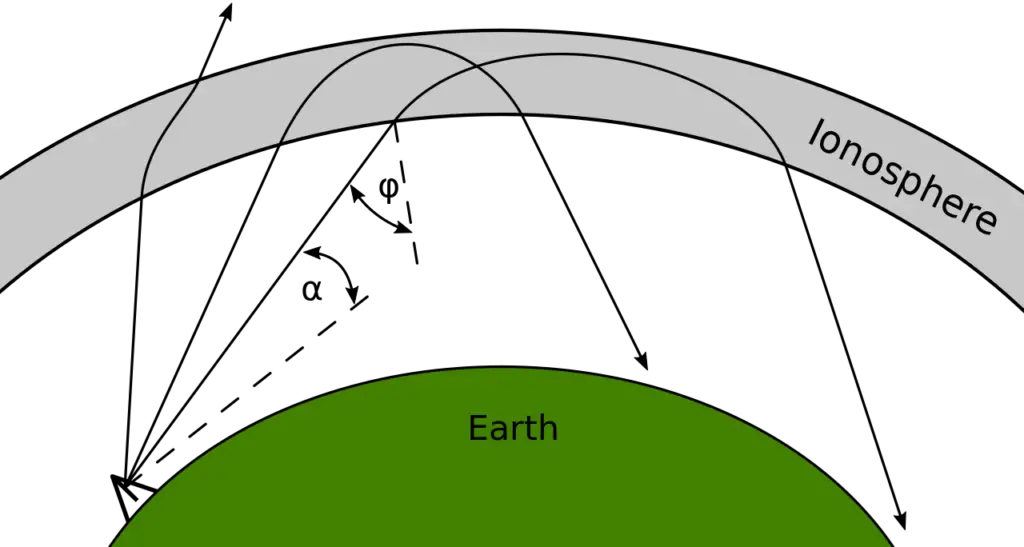
Choosing Appropriate Frequency Bands
For Ground Wave Communication
When aiming for local or regional contacts, operators should favor lower frequency bands, typically within the MF (Medium Frequency, 300 kHz to 3 MHz) and lower HF (High Frequency, 3 to 30 MHz) ranges. These frequencies are more conducive to ground wave propagation, offering stable communication paths without reliance on ionospheric conditions.
For Skywave Communication
For long-distance or international communication, especially during the night when the ionosphere is more reflective, operators can leverage higher HF bands. The choice of frequency within this range depends on several factors, including the time of day, season, and current solar activity. Understanding the concept of the maximum usable frequency (MUF) is crucial here to select bands that will support skywave propagation over the desired distances.
Antenna Placement and Orientation
Optimizing for Ground Wave Propagation
Antennas for ground wave propagation, such as vertical or inverted L antennas, should be placed as high as possible to maximize their range. The orientation is less critical due to the omnidirectional nature of ground wave propagation, but operators should consider minimizing obstructions and maximizing ground conductivity where possible.
Optimizing for Skywave Propagation
For skywave propagation, the type, placement, and orientation of the antenna can significantly impact performance. High-angle radiation is desirable for shorter distances, while lower-angle radiation suits longer distances. Directional antennas, such as Yagi-Udas, can be oriented toward the desired communication area, and their height above ground can be adjusted to favor certain propagation angles.
Tools and Resources for Predicting Propagation Conditions
Several tools and resources are available to amateur radio operators for predicting propagation conditions, aiding in the planning of communication activities:
Software
Propagation prediction software can simulate how radio waves travel through the atmosphere, providing insights into the best times and frequencies for communication. Examples include VOACAP (Voice of America Coverage Analysis Program) and HamCAP.
Online Platforms
Websites and online platforms offer real-time data and forecasts on ionospheric conditions, solar activity, and propagation predictions. Resources like the NOAA Space Weather Prediction Center, DX Maps, and the SolarHam website are invaluable for amateur radio operators looking to optimize their communication strategies.
By integrating a thorough understanding of propagation modes with strategic antenna placement and leveraging predictive tools, amateur radio operators can significantly enhance their ability to communicate across various distances and conditions. This practical application of propagation knowledge empowers the amateur radio community to make more informed decisions, leading to more successful and rewarding radio experiences.
Conclusion
Ground wave and skywave propagation are fundamental phenomena that underpin the success of amateur radio operations, enabling communication over short distances and across continents, respectively. Ground wave propagation, effective at lower frequencies for local to regional contacts, offers reliability and consistency without heavy dependence on atmospheric conditions. In contrast, skywave propagation takes advantage of the ionosphere to bounce radio waves back to Earth, facilitating long-distance communication that can span the globe. This mode, however, introduces variability and challenges, heavily influenced by time of day, solar activity, and atmospheric conditions.
The practical implications of these propagation modes for amateur radio are significant. Selecting appropriate frequency bands, optimizing antenna placement and orientation, and utilizing predictive tools and resources can all dramatically improve the effectiveness of radio communication. A deep understanding of how radio waves propagate allows operators to tailor their strategies to specific communication goals, navigate the challenges posed by changing conditions, and ultimately, achieve more successful and satisfying exchanges.
Embracing the complexity of propagation phenomena enriches the amateur radio experience, merging science with the art of communication. By leveraging knowledge of ground wave and skywave propagation, amateur radio operators not only enhance their operational success but also contribute to a vibrant global community connected by the airwaves.
Explore More…
Dive into the fascinating world of radio wave propagation by experimenting with different bands and times of day to see the effects of ground wave and skywave propagation firsthand. Observing how signals change under various conditions can provide invaluable practical experience and deepen your understanding of these fundamental concepts.
We also encourage you to connect with the wider amateur radio community. Share your experiences, challenges, and discoveries related to propagation. Engaging in discussions, joining forums, and participating in amateur radio clubs can offer new perspectives and insights, enhancing your knowledge and skills. Together, we can continue to explore the mysteries of the ionosphere, push the boundaries of communication, and keep the spirit of amateur radio alive and thriving.
More Reading
For those looking to dive deeper into the distinctions and nuances between ground wave and skywave propagation, as well as their impact on amateur radio, the following resources offer extensive information and insights:
- Wikipedia on Ground Wave Propagation explores the mechanisms by which lower-frequency waves diffract around obstacles and follow the Earth’s curvature, highlighting factors like ground conductivity and the impact of terrain on signal attenuation.
- Wikipedia on Skywave Propagation discusses the effects of geomagnetic storms and sudden ionospheric disturbances on skywave propagation, as well as the history of skywave’s discovery by amateur radio operators, which significantly advanced long-distance radio communication.
- Ham Radio Engineering provides an overview of different propagation modes, including ground wave, space wave, and skywave, with an emphasis on how frequencies and antenna biases influence these propagation methods. It also covers the ionospheric regions (D, E, and F) that affect skywave propagation.
- Cadence PCB Design Blog delves into the factors affecting ground wave propagation, such as terrain conductivity and polarization, and how these elements influence signal frequency and maximum range. The blog also discusses how weather conditions and ionization density impact ground wave propagation.
- Toppr offers an explanation of electromagnetic wave propagation properties, emphasizing that these waves travel at the speed of light and do not require a medium for propagation. It also covers how electromagnetic waves can undergo interference and diffraction.
- BYJU’S outlines the advantages and disadvantages of ground wave propagation, including its ability to bend around obstacles and the attenuation issues at high frequencies. This resource also mentions applications of ground wave propagation, such as military communication with submarines and broadcasting.
- Cadence’s Advanced PCB Design Blog discusses RF propagation types and properties, focusing on the effects of attenuation, fading, refraction, diffraction, and scattering on RF signals. This analysis is crucial for designing wireless communication systems that can navigate the complexities of signal behavior.
- Ham Radio Planet provides a comprehensive overview of types of radio propagation, including ground wave, line-of-sight, tropospheric scatter, skywave, and space propagation. This resource is invaluable for ham radio operators looking to understand the various ways in which radio waves travel through the atmosphere.
Each of these resources provides detailed information on the technical aspects of ground wave and skywave propagation, offering amateur radio enthusiasts the knowledge they need to optimize their communication practices.

